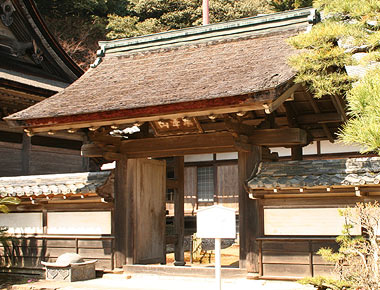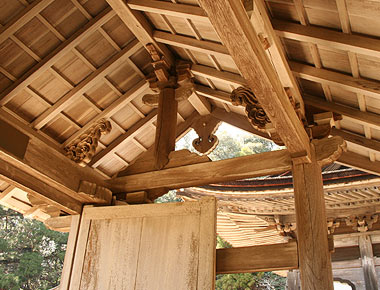|
||
 |
||

 |
Ten'onji Sanmon V¶Rå (Aichi)
@
(C)2001 Japanese Architecture and Art Net Users System.@No reproduction or republication without written permission.
fÚÌeLXgEÊ^ECXgÈÇASÄÌRec̳f¡»E]ÚðֶܷB
|
||||||
| @ | ||||||
| yakuimon@òãå | ||||||
| KEY WORD :@architecture / gates | ||||||
| @ | ||||||
| A gate with a gable roof constructed with two square or rectangular main posts and two square or circular secondary posts *hikaebashira T, set to the rear. A heavy, horizontal beam *kabuki ¥Ø, is set into boat-shaped brackets *funahijiki MIØ, also called *mebari À, and runs transversely on top of the main posts. Other beams *obari jÀ, are placed on top of the boat-shaped brackets and fit over the kabuki by means of cogged joints *watariago näG. These beams extend toward the inner side wall beyond the main posts, and their ends are supported by the secondary posts. They fill the role of a bracket *udegi rØ. The eave purlins *gagyou Û , are supported by these extended transverse beams. The ridge is not set directly above the main pillars and the heavy, horizontal beam. Instead, struts *tsuka ©, are placed at the center of the obari and other diagonal struts *sasuzuka Lñ©, are attached to them. Bearing blocks *masu l, are positioned on top of these struts to carry the ridge *munagi Ø. The center struts may vary in shape: dry squid shape, surumezuka éÆ©; bottle-shaped struts *taiheizuka ¾r©; plectrum-shaped struts *minozuka ª©; or wooden frog-leg struts itakaerumata Âå¯Ò (see *kaerumata å¯Ò). The secondary posts are secured to the main posts by straight, short members which extend through the main pillars and through the secondary pillars. They are tighten by wedges *kusabi ¶. The upper member is called hikaenuki TÑ, the lower one is called ashimoto hikaenuki «{TÑ. The roof is generally gabled *kirizuma yane ØÈ®ª, but on very rare occasions, it is a hip-and-gabled *irimoya yane üê®®ª style. Originally, the gate had no doors but extant examples have them. The use of this type of gate dates back to the late 14c or early 15c. According to the TEIKIN OURAI ëP, the gate was used by doctors and patients and considered lower in rank than the *munamon å. By the Edo period, yakuimon were used as gates for samurai dwellings and on a larger scale 3 bays wide for noblemen's mansions. They were also used for castles. Examples include: Ten'onji Sanmon V¶Rå (mid-17c) in Aichi prefecture, a 1-bay yakuimon with gable roof covered with finely layered shingles *kokerabuki `; Koudaiji Omotemon ä\å (1610) in Kyoto. It is 3-bay yakuimon, with gable roof covered with tile *hongawarabuki {¢. | ||||||
| @ | ||||||

Ten'onji Sanmon V¶Rå (Aichi)
|
||||||
@ |
||||||
| REFERENCES: | ||||||
| *hikaebashira T | ||||||
| EXTERNAL LINKS: | ||||||
| @@ | ||||||
| NOTES: | ||||||
| @ | ||||||
(C)2001 Japanese Architecture and Art Net Users System.@No reproduction or republication without written permission. fÚÌeLXgEÊ^ECXgÈÇASÄÌRec̳f¡»E]ÚðֶܷB |
||||||
| @ |